If you’re looking to add a touch of modern flair to your garden, you may be considering garden edging. Garden edging is the perfect way to add definition and structure to your garden, while also preventing weeds from growing up between your plants. There are many different types of garden edging available today, but how do you choose the right one for your needs and make it look modern? This article will explore some of the most popular types of modern garden edging and offer tips on how to choose the right one for your space.
What is a Garden Edging?
Garden edging is a type of landscaping that defines and outlines the perimeter of a garden or other outdoor space. It is used to create clean lines and provide clarity between different areas in a landscape, as well as add visual interest to an area.
Garden edging can be made from materials such as stones, bricks, metal, plastic, or wood strips. Depending on the material chosen, edging may also serve a practical purpose such as providing stability for retaining walls or reducing soil erosion. Edging can help to prevent grass and weeds from encroaching into your garden beds and pathways.
When it comes to installation, there are many options available for garden edging. You can install it yourself or hire a professional landscaper to do the job for you. The key is to choose an edging material that complements your existing landscape and fits within your budget. With a little bit of planning and some creativity, you can create beautiful garden edges that provide both form and function [1].

7 Reasons Why You Need Garden Edging
Edging Helps Preserve Soil Structure
Good edging helps to keep soils in place, preventing erosion and runoff, which can be damaging to soil structure. Keeping soil in place with edging also helps your garden stay healthy by providing better aeration and drainage. This is especially important if you have a slope or hilly terrain in your garden as it can prevent water from washing away the topsoil.
Edging Creates a Professional Look
Garden edging helps define the boundaries of your garden beds, making them look neat. Creating an edge along the perimeter of your garden will give a clean finished look that will make your gardens stand out from the rest. It’s a simple way to add curb appeal to your home and impress visitors or potential buyers.
Edging Helps Control Weeds
Weeds can be a major problem for any garden. If you create an edging, it will help to control the spread of weeds by keeping them from leaching into other areas of your garden. This will reduce the amount of time you need to spend weeding and make your garden look much neater. Plus, some types of edging even allow for easy weed removal since they are low-lying and easily accessible.
Edging Can Help Prevent Soil Compaction
Garden edging will act as a barrier between soil and foot traffic or animals which can compact soils, making it difficult for roots to penetrate through the soil and get proper access to water, air, and nutrients. This can have a major impact on the growth of your plants since compaction will impede their ability to reach necessary resources.
Edging Can Make Maintenance Easier
Garden edging can make it much easier to maintain your garden. It defines borders between different areas of your garden so that you know exactly where to trim, weed, and mulch. Plus, it’s much easier to remove weeds from an edged area as opposed to an un-edged one since they are more visible and accessible. All in all, having edging around your garden will make maintenance much simpler and ensure that your garden stays neat and orderly for years to come.
Edging Helps Improve Drainage
Good edging can help to improve drainage in your garden since it will keep water from running off the edges and pooling in areas that aren’t meant for standing water. Edging also helps direct water away from plants, minimizing the risk of overwatering or diseases caused by wet feet. This is especially important if you have a slope or hilly terrain since it can help ensure that water doesn’t run off too quickly and erode away valuable topsoil.
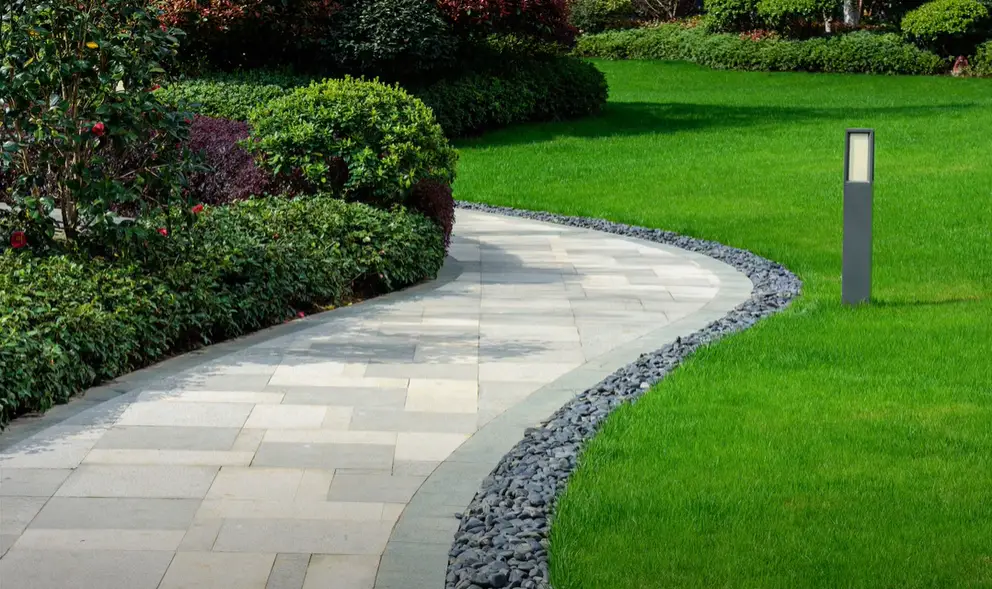
Edging Can Add Visual Interest
Garden edging isn’t just functional but can also be used to add visual interest to your landscape. There are many different styles and materials available so that you can find something that fits with the aesthetic of your garden. You can opt for something subtle and simple or go bold with a more statement-making design. Either way, edging can be an effective way to enhance the look of your outdoor space [2].
How to choose Landscape Edgings?
Types of Edging Materials
When choosing edging materials for your landscape, there are many options available. Some of the most popular options include metal and plastic edgings, natural stone, pavers, and wood.
Metal and plastic edgings are the least expensive option but also the least durable. They can easily be installed using simple tools like a shovel or post-hole digger. This type of edging is not very attractive but it is effective at keeping weeds out of flower beds, lawns, and gardens.
Natural stone is a more attractive option that adds character to any landscape. It comes in various colors and shapes so you can customize your garden’s look to fit your style. However, natural stone can be expensive and challenging to install.
Pavers are an excellent option for defining an area in your landscape. They come in a variety of shapes, sizes, and colors so you can create a border or decorative design with them. However, they can be difficult to install and require regular maintenance such as sealing or cleaning to prevent staining.
Wood is the most cost-effective and attractive option when it comes to edging materials. It is available in different types such as pressure-treated lumber, cedar, redwood, and more. Wood can easily be stained or painted for a customized look that will last for years if properly maintained.
Installation Considerations
Once you decide on the type of edging material you want to use, you will need to consider how it will be installed. If you are using metal or plastic edging, installation is relatively straightforward and can be done with simple tools such as a shovel or a post-hole digger. For natural stone or pavers, however, you may need to hire a professional for the job. Wood edging requires the use of power tools such as saws and drills for installation, which can be dangerous if not done properly.
Finally, make sure that your chosen edging material meets local building codes before installing it in your landscape. This will ensure that it meets all necessary safety standards and helps prevent potential liability issues down the road.
Styles of Landscape Edging
Once you have decided on the type of edging material and installation, you can start thinking about the style of edging that will best complement your landscape. Depending on your budget and personal preference, there are a variety of styles to choose from including scalloped, straight, curved, or decorative designs. The scalloped edging is perfect for flower beds as it gives them a soft, elegant look while straight lines create a classic edge that is great for gardens and paths. Curved edges add interest to any landscape while decorative shapes such as stars or circles can be used to frame specific areas in your garden.
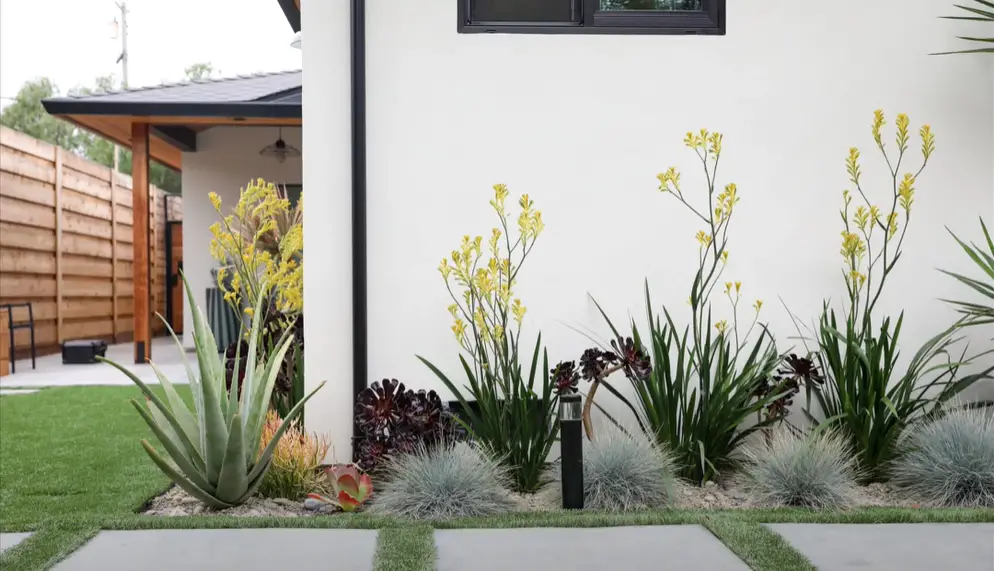
Colors and Finishes
Your chosen edging material can be painted or stained for a unique look that will give your landscape an extra “pop”. Consider the colors of your existing landscape when choosing a stain or paint color and keep in mind that lighter colors will make the edging stand out more while darker shades will blend in with the surroundings. You can also choose from a variety of finishes such as gloss, satin, matte, and semi-gloss to create a customized look.
Costs and Maintenance
The cost of edging materials varies significantly depending on the type and style you choose. Metal and plastic edgings are usually the least expensive option while natural stone or pavers are more costly. Wood is typically more affordable than stone but will require regular maintenance such as sealing, staining, or painting to keep it looking its best over time. The average price of edging materials can range from $20 to $200 for a single linear foot depending on the type and style.
Once your edging is installed, regular maintenance will be necessary to keep it looking its best. This includes removing weeds, trimming plants that are growing over the edge, and replacing damaged parts as needed. You should also check your edging regularly for signs of wear or damage such as cracks or separations in the material that could lead to safety issues down the road.
Modern Garden Edging Ideas for Contemporary Homes
Add Seating to Your Modern Edging
One popular modern garden edging idea is to incorporate seating within the design. This could be achieved through the use of benches and other types of furniture positioned around the perimeter of your garden area. You can choose from a wide range of materials including wood, metal, and even plastic to add a level of style and sophistication to your outdoor space. Not only does this create a cozy atmosphere for relaxing in your garden, but it also provides a great way for you to interact with nature by sitting close to growing plants or flowers.
Install Rock Edges
Another modern edging solution for contemporary homes is rock edging. Rocks come in various sizes, shapes, and colors so it’s easy to find the perfect combination that will complement your outdoor space. Rocks can easily be used along the borders of walkways and driveways, creating a stylish and attractive boundary that will look great for years to come. You can also use them to create an interesting pattern or design around the edge of different parts of your garden such as flower beds, lawns, ponds, and other water features.
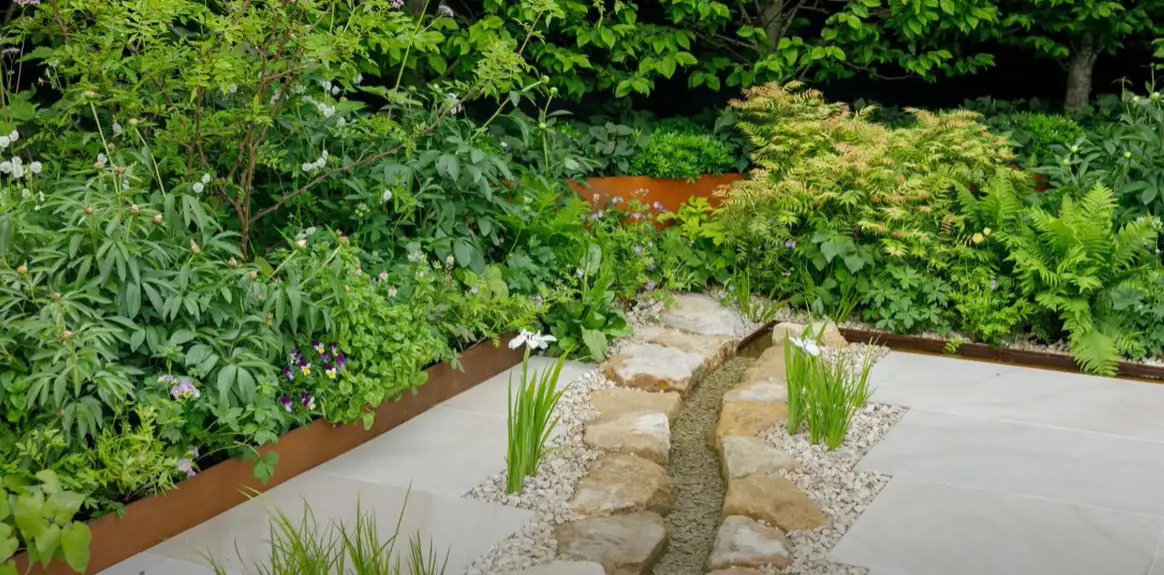
Add Planters
If you’re looking for a simple yet effective modern edging idea, then why not consider adding planters? This is an easy way to enhance the appeal of any garden area while helping to keep it neat. You can find planters in various styles including traditional wooden boxes, metal pots, terracotta vessels, or even hanging baskets. Plus, they provide a great way to add color and interest to your landscape while protecting your plants.
Embrace Weathered Wood
Weathered wood is one of the most popular materials for modern garden edging. Whether you opt for reclaimed boards or newly constructed slats, this type of material can easily be used to create an eye-catching border that will add warmth and character to any outdoor space. Plus, since weathered wood has a naturally distressed look, it’s also incredibly low maintenance which means it requires very little upkeep over time.
Get Creative with Patterned Bricks
Patterned bricks are another great modern edging idea that can help your garden stand out from the rest. By choosing colors and patterns that complement your existing plants and outdoor décor, you’ll be able to create a unique yet cohesive look throughout your landscape. Additionally, this type of edging is easy to install and can be used to create borders around pathways or to frame flower beds.
Combine Timber and Pebbles
If you’re looking for a modern edging option that has a bit of texture and interest, then why not combine timber and pebbles? This is an easy way to create an eye-catching edge along the perimeter of your garden or landscape. You can use larger stones or pebbles as the foundation for your design, then arrange pieces of timber on top in various shapes and sizes. Not only does this help add definition to your outdoor space but it also creates an interesting visual effect that will draw attention.
Put Concrete Pavers To Work
Concrete pavers are an excellent modern edging option for contemporary homes. Not only can they be used to create decorative pathways, but they’re also incredibly durable and low maintenance which means they won’t need to be replaced often. Plus, since concrete pavers come in a wide range of colors and sizes you can easily find the perfect combination that will suit your garden style.
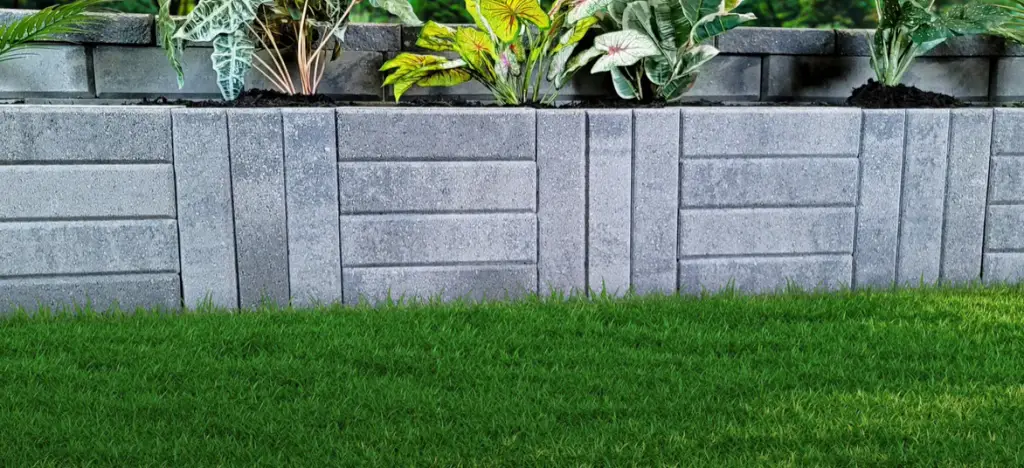
Create an Industrial Look with Black Concrete Blocks
If you’re looking for a modern edging idea that will give your outdoor space an industrial look, then why not consider using black concrete blocks? This type of material is incredibly versatile and can be used to create interesting patterns or designs along the edges of pathways, lawns, and garden beds. Plus, since they’re easy to install and maintain, they’ll provide you with years of use without needing to be replaced.
Make A Statement With Painted Cinder Blocks
Painted cinder blocks are another great modern edging idea that will help your garden stand out from the rest. You can easily paint them in a range of colors to match your existing outdoor décor and plants, or you could even opt for a two-tone design to add an interesting visual element. Best of all, since cinder blocks are incredibly durable and easy to install, they’ll provide you with years of use without needing to be replaced.
Install Pavers Vertically to Create a Modern Edging
You can also create an interesting modern edging design by installing pavers vertically. This type of edging looks great around pathways or garden beds and is incredibly easy to install. Plus, since they come in a wide range of colors and sizes you’ll be able to find the perfect combination that will work with your existing outdoor décor.
Use Gabion Cages for Creative Edging
Why not consider using gabion cages for a creative edging option? Gabions are wire cages that can be filled with stones or other materials of your choice. Not only do they look striking and modern, but they’re also incredibly durable which means you won’t have to worry about them needing to be replaced anytime soon. Plus, since you can fill the cages with unique materials such as recycled glass or colorful pebbles, you can easily create an interesting design that will add character to any outdoor space.
Create Two Different Edging Designs with the Same Brick
If you’re looking for an easy way to create two different edging designs with the same brick, then why not try using a half-cut brick? By cutting the bricks in half and arranging them in different configurations you can easily create a modern edging look that will add texture and interest to any outdoor space. Plus, since this type of edging is incredibly low maintenance you won’t have to worry about it needing to be replaced anytime soon.
Line A Garden With Steel Edging
Steel edging is another modern edging option that’s perfect for contemporary homes. Not only does it look stylish and sleek, but it’s also incredibly durable which means you won’t have to worry about it needing to be replaced anytime soon. Plus, since steel edging comes in a variety of colors and sizes you can easily find the perfect combination that will work with your existing outdoor décor.
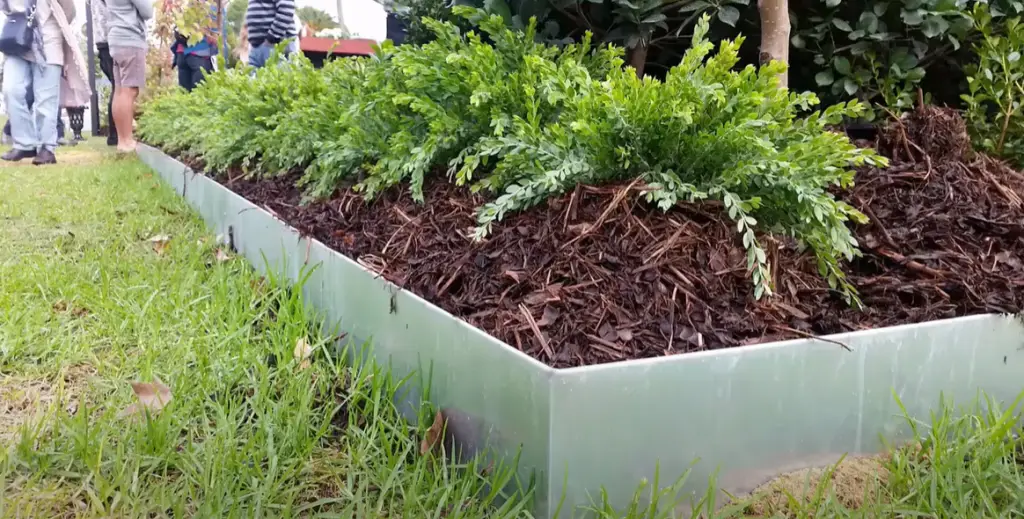
Go For A Natural Look With Bamboo Edging
Bamboo is an excellent choice if you want to create a natural-looking edging around your garden or landscape. Not only does bamboo look great when used as edging, but it’s also incredibly easy to install and maintain which means you won’t have to worry about it needing to be replaced anytime soon. Plus, since bamboo comes in a variety of sizes and colors you can easily find the perfect combination that will suit your garden style.
Make the Corten Steel Edging the Focal Point of Your Garden
Corten steel edging is the perfect modern edging choice if you want to make a statement in your garden. This type of edging has a unique rusted patina that will add texture and interest to any outdoor space. Plus, since corten steel is incredibly durable you won’t have to worry about it needing to be replaced anytime soon.
Include River Rocks in Your Design
River rocks are another great modern edging idea that will add texture and interest to any outdoor space. Not only do they look great, but they’re also incredibly easy to install which means you won’t have to worry about them needing to be replaced anytime soon. Plus, since river rocks come in a variety of sizes and colors you can easily find the perfect combination that will fit your existing outdoor décor.
Go Green With Live Edging
Live edging is an eco-friendly way to create a natural-looking border around your garden or landscape. This type of edging is created using living plants such as perennials, shrubs, and grasses which not only look beautiful but will also help provide much-needed oxygen to the environment. Plus, since live edging is incredibly easy to install and maintain you won’t have to worry about it needing to be replaced anytime soon.

Combine Garden Globes with Gravel for the Most Modern Impression
Garden globes are a modern edging option that adds texture and interest to any outdoor space. Not only do they look striking, but they’re also incredibly easy to install which means you won’t have to worry about them needing to be replaced anytime soon. Plus, by combining garden globes with gravel you can easily create an eye-catching design that will make the most modern impression.
Create Contrast With Concrete Edging
Concrete edging is another great idea if you want to create contrast in your garden or landscape. This type of edging looks great when used with other materials such as stone and brick, and it’s also incredibly durable which means you won’t have to worry about it needing to be replaced anytime soon. Plus, since concrete edging comes in a variety of colors and sizes you can easily find the perfect combination that will work with your existing outdoor décor.
Make a Statement With Copper Edging
Copper edging is an excellent choice if you want to make a statement in your garden or landscape. Not only does it look great when used as edging, but it’s also incredibly durable which means you won’t have to worry about it needing to be replaced anytime soon. Plus, since copper edging comes in a variety of colors and sizes you can easily find the perfect combination that will suit your garden style [3].
Unrivaled Benefits of Metal Garden Edging
Weather Resistant
One of the main benefits of metal garden edging is that it’s weather resistant. Metal edging resists rust and corrosion, making it strong enough to withstand extreme temperatures and weather conditions. This means you won’t have to worry about your edging deteriorating or becoming damaged over time due to harsh climates.
Easy Installation
Compared to other types of garden edging, a big advantage of metal edging is how easy it is to install. Metal comes in pre-cut sections that can be easily connected using clamps and screws. No special tools or skills are required for installation – just a few simple steps and you’re done! Plus, since metal doesn’t require any additional maintenance once installed, you can enjoy your garden for years to come.
Durable and Long Lasting
Metal edging is extremely durable, which means it can withstand a lot of wear and tear. It won’t crack or break like plastic or wood edging can, so you don’t have to worry about replacing it every few years. Plus, metal is much more resistant to the growth of weeds, making it an ideal choice if you’re looking for an easy way to keep them at bay. Furthermore, metal edging won’t rot in damp conditions like other materials, ensuring that your garden stays neat all year round!

Helps Create Clean Separation
Metal garden edging is perfect for creating a clean separation between different areas of your garden. Whether you’re looking to create an attractive border around your flower beds or mark out separate paths, metal edging can help you achieve the desired look. Plus, since it’s so durable and low maintenance, you won’t have to worry about replacing it any time soon.
Aesthetically Pleasing
In addition to its practical benefits, metal edging also adds a touch of style to your garden. With an array of colors and designs available, you can find the perfect edging to complement your outdoor space. Whether it’s a classic black or a modern silver, metal edging is sure to add a sophisticated touch to any garden.
FAQ
How do you use garden edging?
Using garden edging is a great way to enhance the look of your landscaping by creating distinct boundaries between different areas. To use garden edging, you will need to measure and mark the desired boundary lines for your edging. Then, dig out a shallow trench along the marked line and place the edging material in it. Afterward, fill in any gaps with soil or mulch around the edging to secure it into place. Finally, water your new edging regularly to keep it looking fresh and vibrant throughout the season!
What is the point of edging a yard?
Edging a yard helps to create a neat look while also making it easier to maintain. Edging can be used to define flower beds or other plantings, separate different garden areas, prevent weeds from invading your lawn, or reduce the amount of grass that needs to be mowed. Additionally, edging can also help direct water away from walkways, patios, decks, and other structures on your property.
What is the best material for garden edging?
The best material for garden edging will depend on your individual preferences and budget. Popular materials for edging include plastic lattice strips, metal borders such as aluminum flashing, pressure-treated wood timbers, bricks or pavers, stone borders with mortar, and even recycled materials like old tires or glass bottles. Ultimately, the choice of material will depend on what best suits your needs and desired aesthetic.
Do I need to use an edging tool?
Most garden edging materials can easily be installed without the need for any specialized tools; all you usually need is a shovel, some basic hand tools, and possibly a wheelbarrow. However, if you are using heavier materials such as bricks or stones with mortar, then it may be beneficial to invest in an edging tool that helps you create straight lines for a more uniform look.
What can I use instead of landscape edging?
If you don’t want to use traditional edging materials, then there are plenty of alternative options that can give your garden a unique look. Some creative alternatives include using rocks or recycled materials like old window frames, bottles, and tires. Additionally, if you have a larger budget and the necessary tools, you could also consider installing other landscape features such as retaining walls or even an outdoor fireplace to create distinct boundaries between different areas of your yard.
What is the cheapest garden edging?
The cheapest garden edging options are usually plastic lattice strips, metal borders such as aluminum flashing, pressure-treated wood timbers, and even recycled materials like old tires or glass bottles. These materials should be relatively easy to work with and inexpensive compared to more costly options such as brick or stone borders with mortar. However, keep in mind that cheaper materials may not last as long so make sure to research your particular material before buying it.
Useful Video: Modern Garden Edging Ideas
Conclusion
Modern garden edging can be a great way to bring beauty and definition to your garden. It provides an opportunity for you to express yourself through the design and decor of your garden in unique ways. There are many options available when it comes to modern edging, from stone, brick, metal, and plastic materials that can help create the perfect atmosphere and ambiance for your outdoor space. With so many choices available, there is sure to be an edging option that meets your specific needs.
References:
- https://www.bhg.com/gardening/landscaping-projects/landscape-basics/using-landscape-edging/
- https://www.formboss.com.au/5-reasons-why-you-definitely-need-garden-edging/
- https://freshpatio.com/modern-garden-edging-ideas/





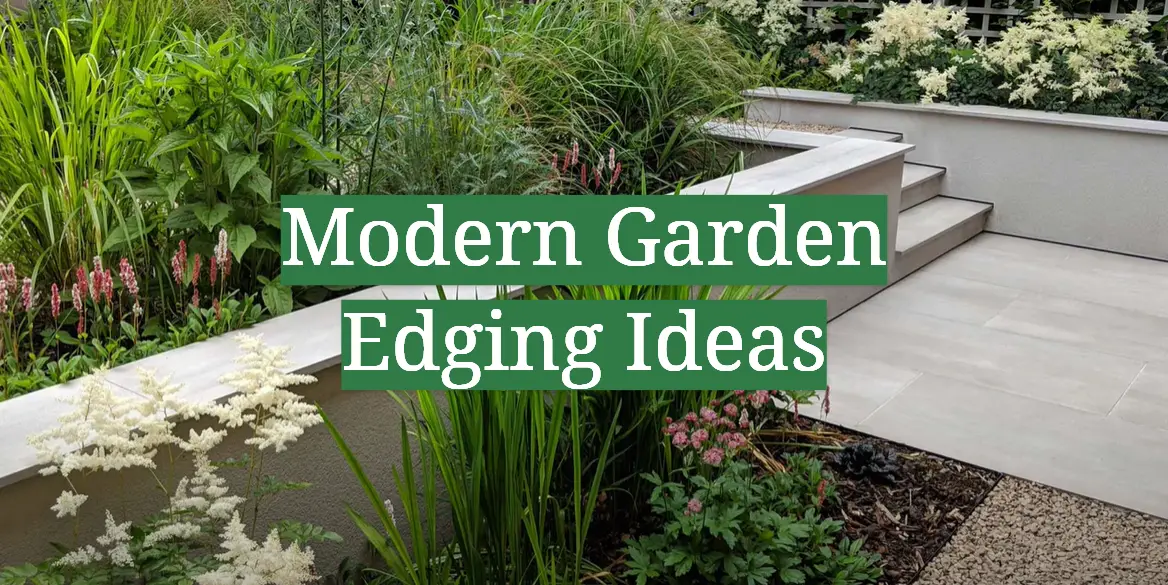




Leave a Reply
View Comments